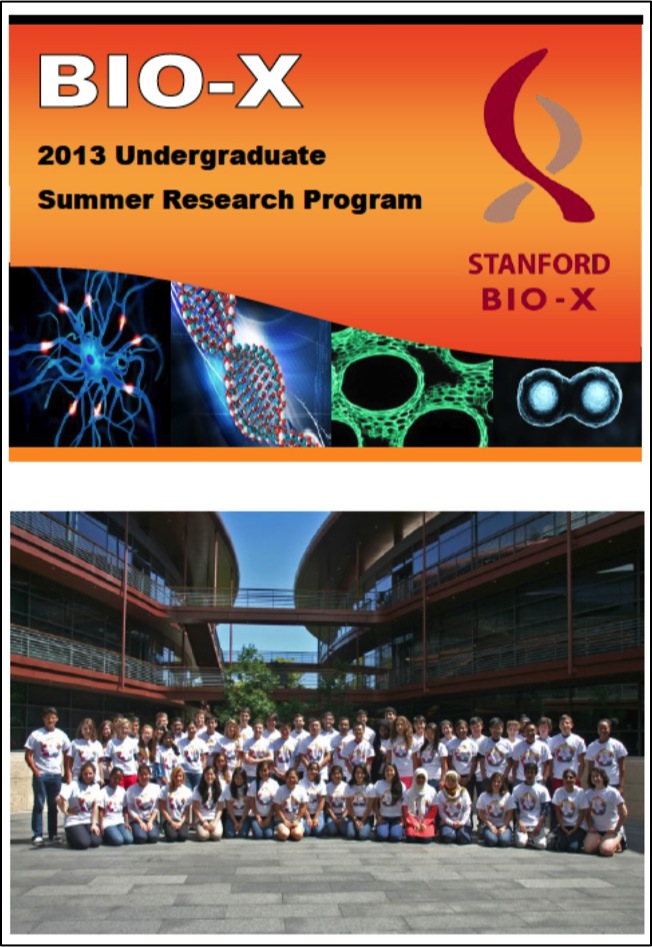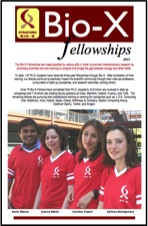
Welcome to the biweekly electronic newsletter from Stanford Bio-X for members of the Bio-X Corporate Forum. Please contact us if you would like to be added or removed from this distribution list, or if you have any questions about Stanford Bio-X or Stanford University.
** On October 9, 2013, Bio-X celebrated the 10th Anniversary of the James H. Clark Center, the hub of Bio-X. Check out CLARK CENTER @ 10X on the SPLASH PAGE as well as the Bio-X Timeline over the last 15 years!!
** Check out the article by Stanford President John Hennessy in the Nov/Dec 2013 issue of the Stanford Magazine on Bio-X and the Clark Center, "A Cauldron of Innovation".
Seed Grants
 SEED GRANTS FOR SUCCESS - Stanford Bio-X Interdisciplinary Initiatives Program (IIP)
SEED GRANTS FOR SUCCESS - Stanford Bio-X Interdisciplinary Initiatives Program (IIP)
The Bio-X Interdisciplinary Initiatives Program represents a key Stanford Initiative to address challenges in human health. The IIP awards approximately $3 million every other year in the form of two-year grants averaging about $150,000 each. From its inception in 2000 through the fifth round in 2010, the program has provided critical early-stage funding to 114 different interdisciplinary projects, involving collaborations from over 300 faculty members, and creating over 450 teams from five different Stanford schools. From just the first 5 rounds, the IIP awards have resulted in a 10-fold-plus return on investment, as well as hundreds of publications, dozens of patents filed, and most importantly, the acceleration of scientific discovery and innovation.
In 2012, Stanford Bio-X selected 23 new seed grant projects as the winners of the 6th round. Please go here to view the list of awardees, along with the titles of their projects and the abstracts of the research. Competition was intense as the awardees were chosen from 118 Letters of Intent (LOIs). Selection criteria included innovation, high-reward, and interdisciplinary collaboration. (To view the 114 other IIP projects that have been funded from the first 5 rounds, please click here.) In addition, SANOFI has also funded 4 new Bio-X IIP Seed Grant projects from round 6!
On Monday, August 26, 2013, Bio-X had its second annual IIP Symposium of the year at the Clark Center, which highlights projects that exemplify the Stanford Bio-X mission of crossing boundaries to bring about interdisciplinary research and solutions in the field of life bioscience. The symposium was a huge success with over 300 people attending this event, which included 8 oral presentations and 136 poster presentations. Recorded talks from the symposium will be uploaded soon. If you'd like to view the talks for previous symposia through the years, please click here.
We are cultivating and are highly successful in building meaningful collaborations with numerous corporate colleagues. New collaborations through our seed grant projects are highly encouraged. To learn about how to get involved, please contact Dr. Hanwei Li or Dr. Heideh Fattaey.
Fellowships
Every year, graduate students and postdoctoral scholars of Bio-X affiliated faculty are highly encouraged to apply for the Bio-X Fellowships, which are awarded to research projects that are interdisciplinary and utilize the technologies of different fields to solve different biological questions. Students are encouraged to work collaboratively with professors of different departments, thus creating cross-disciplinary relationships among the different Stanford schools. Our fellows have conducted exciting research, resulting in publications in high-impact journals and have been offered excellent positions in industry and academia. To date, Stanford Bio-X has a total of 152 Fellows.
On June 26th, Bio-X held its annual Bio-X Fellows Symposium, where there were four 15-minute oral presentations followed by one-minute spiels from current fellows. The 25 newest fellows selected this year were also announced, and about 100 attendees came to the symposium. Please click on the "Bio-X Fellows Symposium" link above for the agenda and titles of the talks, and on the icon of the brochure above for the updated and latest Bio-X Fellowships brochure.
To view the numerous projects that have been awarded over the years, please click here.
 BIO-X UNDERGRADUATE SUMMER RESEARCH PROGRAM
BIO-X UNDERGRADUATE SUMMER RESEARCH PROGRAM
The Bio-X Undergraduate Summer Research Program supports undergraduate research training through an award designed to support interdisciplinary undergraduate summer research projects. The program is an invaluable opportunity for students to conduct hands-on research, learn how to carry out experiments in the laboratory, and develop the skills to read and analyze scientific literature.
This program is eligible to Stanford students who want to work in the labs of Bio-X affiliated faculty. To date, 241 students have been awarded the opportunity to participate in the Bio-X Undergraduate Summer Research Program. This summer is Stanford Bio-X's 8th round of USRP.
Participating undergraduates are also required to present poster presentations on the research that they've conducted during the program. Please click here for title lists of past posters that our undergraduates have presented.
Many fruitful collaborations and relationships have been established with industry through fellowships. Please contact Dr. Hanwei Li or Dr. Heideh Fattaey if you'd like to learn more about how to get involved with these fellowship programs.
News
 The Will to Persevere Induced by Electrical Stimulation of the Human Cingulate Gyrus
The Will to Persevere Induced by Electrical Stimulation of the Human Cingulate Gyrus
Bio-X Affiliated Faculty Josef Parvizi
Publication in Neuron; Bio-X NeuroVentures project
NPR feature as an attachment to the newsletter email
Abstract: Anterior cingulate cortex (ACC) is known to be involved in functions such as emotion, pain, and cognitive control. While studies in humans and nonhuman mammals have advanced our understanding of ACC function, the subjective correlates of ACC activity have remained largely unexplored. In the current study, we show that electrical charge delivery in the anterior midcingulate cortex (aMCC) elicits autonomic changes and the expectation of an imminent challenge coupled with a determined attitude to overcome it. Seed-based, resting-state connectivity analysis revealed that the site of stimulation in both patients was at the core of a large-scale distributed network linking aMCC to the frontoinsular and frontopolar as well as some subcortical regions. This report provides compelling, first-person accounts of electrical stimulation of this brain network and suggests its possible involvement in psychopathological conditions that are characterized by a reduced capacity to endure psychological or physical distress.

 Stanford Bio-X researchers develop new technology to study hearing
Stanford Bio-X researchers develop new technology to study hearing
Bio-X Affiliated Faculty Beth Pruitt and Anthony Ricci
Bio-X IIP Seed Grant Project
Much of what is known about sensory touch and hearing cells is based on indirect observation. Scientists know that these exceptionally tiny cells are sensitive to changes in force and pressure. But to truly understand how they function, scientists must be able to manipulate them directly. Now, Stanford scientists are developing a set of tools that are small enough to stimulate an individual nerve or group of nerves, but also fast and flexible enough to mimic a realistic range of forces. A team of mechanical engineers from Stanford and ear specialists from the Stanford School of Medicine is developing a new device, known as a force probe, that allows the researchers to study the flexible hair cells that translate sound waves into electrical signals. The probe works at a range of frequencies that are more realistic to human hearing than previous machines. ... The tool, developed with funding from Stanford's Bio-X program, vibrates the hair cells to mimic the effect of incoming sound waves. This allows the researchers to study the cause-and-effect relationships between the forces exerted in hair cells by sound waves and the electrical signals they produce in response. ... Understanding the mechanics of how cells register these sensory inputs could lead to innovative new treatments and prosthetics. For example, [Professors Beth Pruitt and Anthony Ricci] think their research could help bioengineers build a better hair cell for people with impaired hearing from damage to their natural hair cells.
In U.S. first, Stanford researchers record data from brain of ambulatory Parkinson's patient
Bio-X Affiliated Faculty Helen Bronte-Stewart and Neurosurgery Faculty Jaimie Henderson
Stanford University School of Medicine investigators have successfully implanted and recorded data from a device that not only generates electrical impulses to tame symptoms of Parkinson's disease, but also continuously monitors and records brain activity in a key affected structure deep within the patient's brain. This second-generation version of an existing deep-brain-stimulation, or DBS, device will allow neuroscientists to noninvasively capture vast amounts of information about the patient's brain-firing patterns to discern the "neural signatures" characterizing that patient's symptoms, gain insights about the progression of the disease, and ultimately, it is hoped, develop algorithms for automating the device's signaling program so that it adjusts in response to changes in brain activity. "We have high hopes that discoveries made possible by this new DBS system will fuel the development of new, personalized treatments for a range of neurological disorders," said Helen Bronte-Stewart, MD, professor of neurology and neurological sciences at the medical school and director of the Comprehensive Movement Disorders Center at Stanford Hospital & Clinics, who is leading the effort. "With this 'brain radio,' we can study the brain's signaling patterns at the same time that we're observing a patient's precise movements — whether intended or not — with the goal of understanding just which brain rhythms correspond to which specific patterns of movement."
Events
| Bioengineering December 12, 2013, 11 am - 12 pm Clark Center S360, Stanford, CA Frontiers in Quantitative Biology Seminar Series Speaker: Thierry Emonet, Assoc. Professor of Molecular, Cellular and Dev. Biology |
Nanobiotechnology Seminar Series December 12, 2013, 5:30 pm - 6:30 pm Munzer Auditorium, Stanford, CA "Dartmouth Center for Cancer Nanotechnology Excellence" Speaker: Ian Baker, PhD, Dartmouth College |
Resources
| Stanford University |
| Stanford Bio-X |
| Bio-X Seed Grants The Stanford Bio-X Interdisciplinary Initiatives Program (IIP) provides seed funding for high-risk, high-reward, collaborative projects across the university, and have been highly successful in fostering transformative research. |
| Office of Technology and Licensing "Techfinder" Search the OTL Technology Portal to find technologies available for licensing from Stanford. |
| Stanford Center for Professional Development - Take advantage of your FREE membership! - Take online graduate courses in engineering, leadership and management, bioscience, and more. - Register for free webinars and seminars, and gets discounts on courses. |
| Stanford Biodesign Video Tutorials on how FDA approves medical devices A series of video briefs recently produced by the Stanford Biodesign Program teaches innovators how to get a medical device approved for use in the United States. This free, online library of 60 videos provides detailed information on the Food and Drug Administration regulatory process, short case studies and advice on interacting with the FDA. |
To learn more about Stanford Bio-X or Stanford University, please contact Dr. Hanwei Li, the Bio-X Corporate Forum Liaison, at 650-725-1523 or lhanwei1@stanford.edu, or Dr. Heideh Fattaey, the Executive Director of Bio-X Operations and Programs, at 650-799-1608 or hfattaey@stanford.edu.


